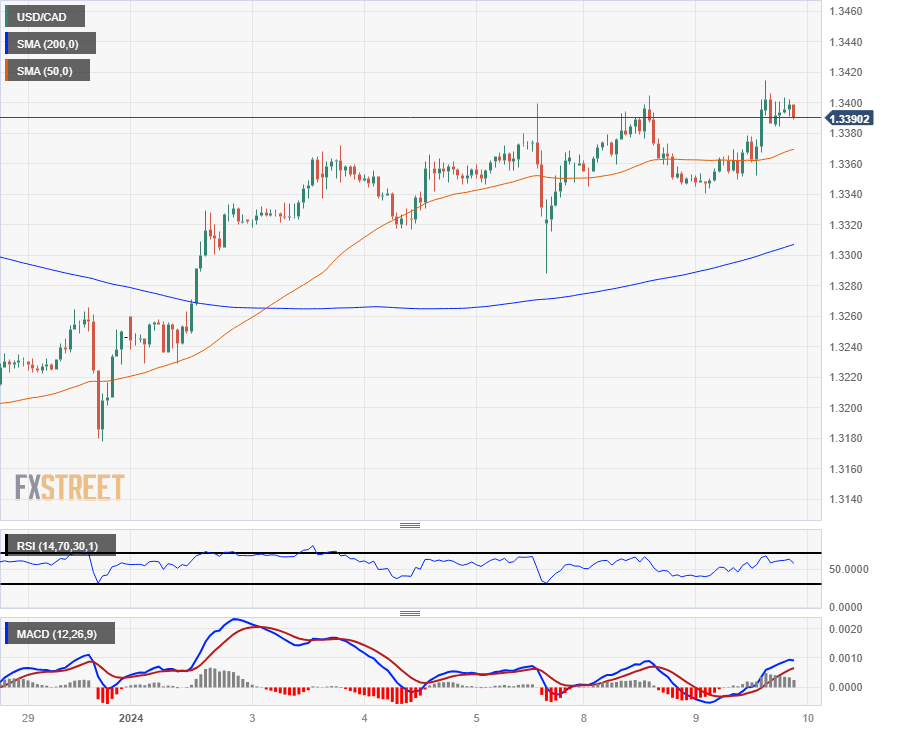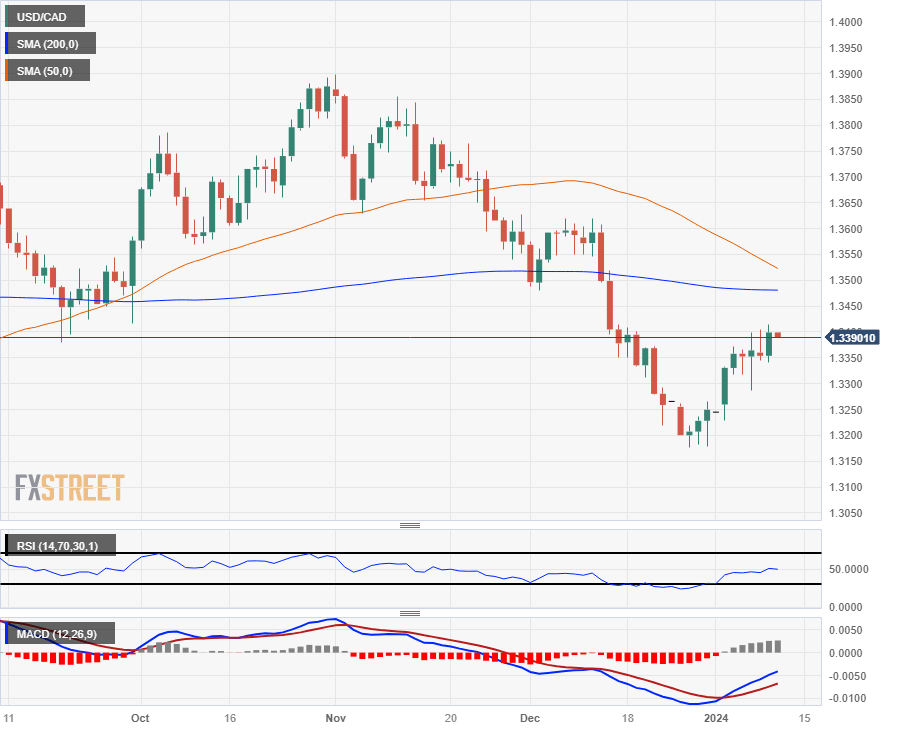Canadian Dollar falls back Tuesday after Canadian Trade Balance misses the mark

Most recent article: Canadian Dollar middles with all eyes on US CPI inflation
- Canadian Dollar falls back, while US Dollar moves broadly higher.
- Canada International Merchandise Trade fell further than expected, Building Permits also declined.
- Crude Oil market recovery sees friction, limiting CAD support.
The Canadian Dollar (CAD) extended declines on Tuesday, slipping to a new low for the week as market sentiment recoils in the last quarter of the trading day. Markets pulled back into the US Dollar (USD), pushing the CAD even lower as Canadian economic figures broadly miss the mark.
Canada’s International Merchandise Trade in November fell back after October’s 14-month high, and Canadian Building Permits in November fell by nearly 4%.
Crude Oil is looking for a rebound from Monday’s downside slump, but topside momentum remains limited, leaving Crude Oil largely flat on the week as barrel bids struggle to recover.
Daily digest market movers: Canadian Dollar hesitates amidst US Dollar recovery
- Canada trade balance heads back toward the median: November’s International Merchandise Trade Balance slid from October’s 14-month peak of CAD 3.2 billion to 1.57 billion, with October seeing an upside revision from 2.97 billion.
- Canada Building Permits also fell more than expected in November, declining 3.9% versus the forecast of -1.7%.
- October’s Building Permits grew by 3% after an upside revision from 2.3%.
- The US trade deficit fell less than expected with the Goods Trade Balance for November bouncing slightly from a slightly-revised -90.3 billion to -89.4 billion.
- November’s US Goods and Services Trade Balance likewise fell less than expected, reaching $-63.2 billion versus the forecast of $-65.0 billion. October saw a minor revision from $-64.3 billion to $-64.5 billion.
- Market focus will be squarely on Thursday’s US Consumer Price Index (CPI) inflation print, where headline CPI inflation is expected to rise to 3.2% YoY in December.
Canadian Dollar price today
The table below shows the percentage change of Canadian Dollar (CAD) against listed major currencies today. Canadian Dollar was the strongest against the Swiss Franc.
| USD | EUR | GBP | CAD | AUD | JPY | NZD | CHF | |
| USD | 0.18% | 0.27% | 0.29% | 0.46% | 0.17% | 0.17% | 0.51% | |
| EUR | -0.18% | 0.09% | 0.11% | 0.26% | -0.02% | 0.00% | 0.32% | |
| GBP | -0.26% | -0.08% | 0.04% | 0.19% | -0.09% | -0.10% | 0.25% | |
| CAD | -0.29% | -0.11% | -0.03% | 0.15% | -0.13% | -0.13% | 0.22% | |
| AUD | -0.46% | -0.27% | -0.18% | -0.15% | -0.28% | -0.28% | 0.04% | |
| JPY | -0.17% | 0.02% | 0.11% | 0.14% | 0.30% | 0.01% | 0.35% | |
| NZD | -0.16% | 0.01% | 0.11% | 0.13% | 0.28% | 0.00% | 0.35% | |
| CHF | -0.53% | -0.35% | -0.26% | -0.24% | -0.09% | -0.37% | -0.37% |
The heat map shows percentage changes of major currencies against each other. The base currency is picked from the left column, while the quote currency is picked from the top row. For example, if you pick the Euro from the left column and move along the horizontal line to the Japanese Yen, the percentage change displayed in the box will represent EUR (base)/JPY (quote).
Technical Analysis: Canadian Dollar gives up further ground on Tuesday as markets pick up the Greenback
The Canadian Dollar (CAD) slid to a new multi-week low against the US Dollar on Tuesday, sending the USD/CAD pair briefly back over the 1.3400 price level before intraday price action got hung up on the major handle. Near-term USD/CAD momentum has largely been a consolidation story with the pair grinding out higher lows through 2024’s early trading.
Daily candlesticks show the USD/CAD pushing steadily higher in choppy trading as the pair grinds back toward the 200-day Simple Moving Average (SMA) near the 1.3500 handle. Bullish momentum is set to see a fresh technical ceiling from an impending bearish crossover of the 50-day and 200-day SMAs.
USD/CAD Hourly Chart

USD/CAD Daily Chart

Canadian Dollar FAQs
What key factors drive the Canadian Dollar?
The key factors driving the Canadian Dollar (CAD) are the level of interest rates set by the Bank of Canada (BoC), the price of Oil, Canada’s largest export, the health of its economy, inflation and the Trade Balance, which is the difference between the value of Canada’s exports versus its imports. Other factors include market sentiment – whether investors are taking on more risky assets (risk-on) or seeking safe-havens (risk-off) – with risk-on being CAD-positive. As its largest trading partner, the health of the US economy is also a key factor influencing the Canadian Dollar.
How do the decisions of the Bank of Canada impact the Canadian Dollar?
The Bank of Canada (BoC) has a significant influence on the Canadian Dollar by setting the level of interest rates that banks can lend to one another. This influences the level of interest rates for everyone. The main goal of the BoC is to maintain inflation at 1-3% by adjusting interest rates up or down. Relatively higher interest rates tend to be positive for the CAD. The Bank of Canada can also use quantitative easing and tightening to influence credit conditions, with the former CAD-negative and the latter CAD-positive.
How does the price of Oil impact the Canadian Dollar?
The price of Oil is a key factor impacting the value of the Canadian Dollar. Petroleum is Canada’s biggest export, so Oil price tends to have an immediate impact on the CAD value. Generally, if Oil price rises CAD also goes up, as aggregate demand for the currency increases. The opposite is the case if the price of Oil falls. Higher Oil prices also tend to result in a greater likelihood of a positive Trade Balance, which is also supportive of the CAD.
How does inflation data impact the value of the Canadian Dollar?
While inflation had always traditionally been thought of as a negative factor for a currency since it lowers the value of money, the opposite has actually been the case in modern times with the relaxation of cross-border capital controls. Higher inflation tends to lead central banks to put up interest rates which attracts more capital inflows from global investors seeking a lucrative place to keep their money. This increases demand for the local currency, which in Canada’s case is the Canadian Dollar.
How does economic data influence the value of the Canadian Dollar?
Macroeconomic data releases gauge the health of the economy and can have an impact on the Canadian Dollar. Indicators such as GDP, Manufacturing and Services PMIs, employment, and consumer sentiment surveys can all influence the direction of the CAD. A strong economy is good for the Canadian Dollar. Not only does it attract more foreign investment but it may encourage the Bank of Canada to put up interest rates, leading to a stronger currency. If economic data is weak, however, the CAD is likely to fall.
Author

Joshua Gibson
FXStreet
Joshua joins the FXStreet team as an Economics and Finance double major from Vancouver Island University with twelve years' experience as an independent trader focusing on technical analysis.

















